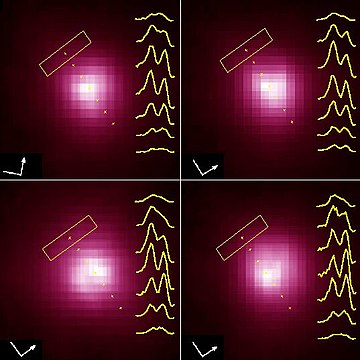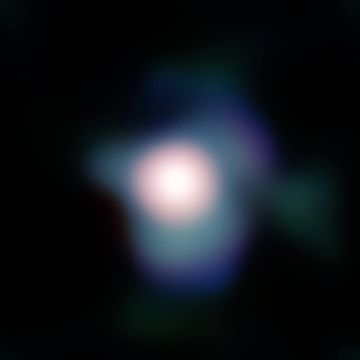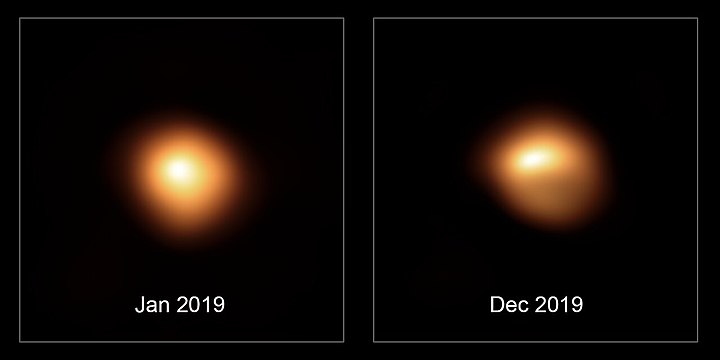Betelgeuse
|
Star Betelgeuse (α Orionis) |
|||||||||||||||||||||
|---|---|---|---|---|---|---|---|---|---|---|---|---|---|---|---|---|---|---|---|---|---|
| AladinLite | |||||||||||||||||||||
|
Observation dates equinox : J2000.0 , epoch : J2000.0 |
|||||||||||||||||||||
| Constellation | Orion | ||||||||||||||||||||
| Right ascension | 05 h 55 m 10.31 s | ||||||||||||||||||||
| declination | + 07 ° 24 ′ 25.4 ″ | ||||||||||||||||||||
| Angular expansion | 50 mas | ||||||||||||||||||||
| Apparent brightness | 0.42 (0 to 1.6) mag | ||||||||||||||||||||
| Typing | |||||||||||||||||||||
| B − V color index | +1.85 | ||||||||||||||||||||
| U − B color index | +2.32 | ||||||||||||||||||||
| Spectral class | M1-2 Ia-Iab | ||||||||||||||||||||
| Variable star type | SRC | ||||||||||||||||||||
| Astrometry | |||||||||||||||||||||
| Radial velocity | (+21.0 ± 0.9) km / s | ||||||||||||||||||||
| parallax | approx. 4.51-6.55 mas | ||||||||||||||||||||
| distance | about 500-720 light years around 153-222 pc |
||||||||||||||||||||
| Visual absolute brightness M vis | −5.0 to −5.3 mag | ||||||||||||||||||||
| Proper movement | |||||||||||||||||||||
| Rec. Share: | 27.33 mas / a | ||||||||||||||||||||
| Dec. portion: | 10.86 mas / a | ||||||||||||||||||||
| Physical Properties | |||||||||||||||||||||
| Dimensions | ≈ 20 M ☉ | ||||||||||||||||||||
| radius | 950-1200 R ☉ | ||||||||||||||||||||
| Luminosity |
approx. 55,000 L ☉ |
||||||||||||||||||||
| Effective temperature | 3,450 K | ||||||||||||||||||||
| Rotation time | 2070 to 2355 d | ||||||||||||||||||||
| Age | approx. 10 mill. a | ||||||||||||||||||||
|
Other names and catalog entries |
|||||||||||||||||||||
|
|||||||||||||||||||||
Betelgeuse [ ˌbetaɪɡɔɪtsə ] ( , too) α Orionis called, international: Betelgeuse ( Arabic يد الجوزاء, DMG yad al-ǧauzāʾ , "hand of the twins"), is a star in the constellation Orion . He is also called the shoulder star of Orion . The difference to the official spelling is due to a "historical spelling mistake". Although with α referred to , he is behind Rigel (mag 0.12) only the second brightest star of Orion.
properties
Betelgeuse is a giant star belonging to the Milky Way and is assigned to the class of red supergiants in the Hertzsprung-Russell diagram . It is about a thousand times the diameter of the sun and in the visible range it is about ten thousand times as bright. In terms of volume, the sun fits into Betelgeuse about a billion times. Seen from Earth , Betelgeuse is the tenth brightest star .
Betelgeuse is of great astronomical interest. Its radius was the first to be determined using interferometry . It turned out to be about 15 percent. Betelgeuse's brightness also varies between +0.3 and +0.6 m with a semi-regular period of 2070 days ( semi-regular variable of type SRc). Along with Mira , Altair and Antares, it is one of the few stars that can be seen as a surface from Earth using telescope technology . Its angular diameter is 0.05 arc seconds.
Speaking at a coverage of Betelgeuse through the asteroid (319) Leona on December 12, 2023 it will be possible in some circumstances to determine the distribution of brightness over the star disk more accurately than is possible with the current technology.
Determining the distance from Betelgeuse is proving difficult because the parallax is significantly less than the angular diameter of the star. For a long time it was assumed a distance of around 700 light years . Data from the Hipparcos satellite show a geometric parallax of (6.55 ± 0.83) milli-arcseconds , which suggests a distance of (153 +22 -17 ) parsecs or (499 +72 -55 ) light years. However, more recent analyzes of further observational data indicate a smaller parallax of only (4.51 ± 0.80) milli-arcseconds, which results in a greater distance of (222 +48 -34 ) parsecs or (724 +156 -111 ) light years.
High-resolution image of the VLT-NACO using Lucky Imaging
Future as a supernova
As a red supergiant , Betelgeuse will end his life as a supernova . The opinions of astrophysicists as to when this can be expected differ: some expect it to be within the next thousand years, others not before a hundred thousand years.
With red supergiants, one can expect a 16,000-fold increase in luminosity in a supernova (on average). In the case of Betelgeuse, it would be unmistakable on earth. In relation to an initial brightness of around 0.5 mag, the apparent brightness in the case of a supernova would increase to −9.5 to −10.5 mag, corresponding to an absolute brightness of −15.1 to −16.1. This corresponds to the luminosity of a crescent moon in the sky. According to other sources, supernova outbursts of dying giant stars even reach absolute magnitudes of −17 to −18, occasionally (especially with stars with a very large radius) even above. In the latter case, the supernova would reach the brightness of the full moon. Since the star's axis of rotation does not point towards Earth, the gamma-ray flash would not be so strong that the biosphere would be affected.
The remnant of this supernova is expected to be a neutron star due to its mass of 20 solar masses .
Measurements at California universities showed in 2009 that the diameter of the star has shrunk by 15 percent since 1993, while the light intensity has remained unchanged.
From October 2019 a significant decrease in brightness was observed at Betelgeuse. In February 2020, the star's brightness passed through a minimum of +1.61 mag, while its luminosity fell to a little less than 40% of its average value. It appeared weaker than ever since the beginning of precise observations. At this point, 20 stars exceeded him in brightness. As a variable star, Betelgeuse is usually one of the ten brightest stars in the night sky. The significant decrease in brightness was initially interpreted differently among the scientists. Some saw it as "a coincidental superposition of the minima of several ordinary brightness cycles", others interpreted it as a sign of an imminent core collapse supernova . Comparative recordings with the Very Large Telescope of the European Southern Observatory showed the changes in Betelgeuse, both in terms of its luminosity and its external shape, between January and December 2019. Initial explanations were both from not yet understood processes inside the star as well as from ejected cooler material, which absorbs part of the light emitted by Betelgeuse. However, observations in the sub-millimeter range seemed to rule out a significant contribution from the absorption of light by dust. Instead, it was suggested that star spots could have been the reason for the reduction in brightness. At the end of April 2020, the star returned to its old luminosity. In August 2020, the phenomenon of the obscuration of Betelgeuse was finally clarified as part of a research project by the Harvard-Smithsonian Center for Astrophysics on the basis of observations with the Hubble space telescope . It showed that Betelgeuse ejected a huge, hot and dense cloud of material into space, which then cooled to dust, shielding the light from the star, making Betelgeuse appear darker from the viewer's point of view on Earth.
Betelgeuse in January and December 2019, recorded with the Very Large Telescope of the European Southern Observatory .
Etymology and forms of names
The name comes from Arabic يد الجوزاء, DMG yad al-ǧauzāʾ ("hand of the [constellation] Gemini ", "hand of the giantess"). It already appears in the book of the constellations of fixed stars by the Persian astronomer Abd ar-Rahman as-Sufi († 986).
The current German name form arose because the Arabic first letter Ya (يـwith two dots) incorrectly as Ba (بـwith a dot) and thus transcribed into Latin . During the entire Renaissance period the star was called Bait al-Jschauza , with the meaning assumed in the Arabic original as "armpit of the giantess", although the correct translation of "armpit"ابط, DMG Ibṭ would have been. This is where the name Betelgeuse came from .
Due to the red color (symbolic of fire or blood) that can be seen with the naked eye, the star (like the planet Mars ) has been associated with war. Since it is the first star of Orion to appear above the horizon, it was also called the "Herald" in ancient times.
The following are terms in different languages and cultures:
- al-Dhira /الذراع / al-Ḏirāʿ (the arm)
- al-Mankib /المنكب (the shoulder)
- al-Yad al-Yamin /اليد اليمين (the right hand)
- Ardra ( Hindi )
- Bahu ( Sanskrit )
- Bed Elgueze
- Beit Algueze
- Besn ( Persian ) (the arm)
- Betelgeuse
- Beteliguex
- Betelgeuze (Bet El-geuze)
- Бетельгейзе (Russian)
- Betelgez / Бетелгез ( Serbian )
- Betelgeza ( Slovenian )
- Betelguex
- Gula ( Euphratic )
- Ied Algeuze (Orion's Hand)
- Klaria ( Coptic ) (little arms)
- Yedelgeuse
- 平 家 星 ( Japanese ) (The star of the Heike clan )
- 参 宿 四 (Shēnxiùsì, Chinese : "Fourth star of the three-star constellation")
Betelgeuse in literature and film
In Douglas Adams ' five volume trilogy The Hitchhiker's Guide to the Galaxy , Betelgeuse is the home system of Ford Prefect and Zaphod Beeblebrox.
The fictional plot of Pierre Boulle's book The Planet of the Apes takes place on a planet in the solar system of Betelgeuse , which - in modified form - has already been filmed several times (including 1968 by Franklin J. Schaffner , 2001 by Tim Burton and 2011 by Rupert Wyatt ) .
Arno Schmidt refers to Betelgeuse in the physical treatises of his story Leviathan .
In 1982 the science fiction novel Zielstern Beteigeuze by Karl-Heinz Tuschel was published in the GDR .
Under its French name Betelgeuze, the star is the scene of the comic series of the same name by the Brazilian comic artist Léo . Much of the action takes place on Betel-6, the (fictional) sixth planet around the star Betelgeuse.
The name Beetlejuice (English literally beetle juice ) from the film of the same name by Tim Burton is a corruption of the English name of the star Betelgeuse . The main character Betelgeuse uses this spelling to be able to represent her name symbolically in a charade .
The system of the star Betelgeuse is the central plot in issue 48 - Red Eye Betelgeuse - the science fiction novel series Perry Rhodan .
Betelgeuse appears in some Philip K. Dick novels and short stories.
Ijon Tichy also begins his adventurous journey through time on the way to this star in Stanisław Lem's book Star Diaries .
In the children's book Angstmän (as well as in the radio play of the same name) by Hartmut El Kurdi , the title hero (an extraterrestrial superhero) asks the girl Jennifer: “Braunschweig? Is that east or west of Betelgeuse? "
See also
Web links
- The range of Betelgeuse
- Size comparison with other celestial bodies
- scinexx.de: Red supergiant spews matter July 30, 2009
- Beteigeuze (English) on solstation.com
- ESO : A detailed look at Betelgeuse shows how giant stars lose mass + photos & animation - July 29, 2009
- ESO: The blazing flames of Betelgeuse + photo, map & animation - June 23, 2011
- ESO: Size comparison: Betelgeuse and the sun June 26, 2017
- Scienceticker.info: Giant star Betelgeuse is shrinking June 9, 2009
- The stained surface of Betelgeuse - Astronomy Picture of the Day from January 6, 2010.
Individual evidence
- ↑ a b c d e alf Ori. In: SIMBAD . Center de Données astronomiques de Strasbourg , accessed September 8, 2018 .
- ↑ a b alf Ori. In: VSX. AAVSO, accessed September 8, 2018 .
- ↑ a b c Betelgeuse Jürgen Kummer, accessed on September 25, 2008
- ^ A b c d F. van Leeuwen: Validation of the new Hipparcos reduction . In: Astronomy & Astrophysics . tape 474 , no. 2 , November 2007, ISSN 0004-6361 , p. 653-664 , doi : 10.1051 / 0004-6361: 20078357 ( aanda.org [accessed August 3, 2020]).
- ↑ a b c G. M. Harper, A. Brown, EF Guinan, E. O'Gorman, AMS Richards: An Updated 2017 Astrometric Solution for Betelgeuse . In: The Astronomical Journal . tape 154 , no. 1 , June 16, 2017, ISSN 1538-3881 , p. 11 , doi : 10.3847 / 1538-3881 / aa6ff9 ( iop.org [accessed August 3, 2020]).
- ^ S. Mohamed, J. Mackey, N. Langer: 3D Simulations of Betelgeuse's Bow Shock . In: Astronomy & Astrophysics . 541, id. A1, 2012, p. A1. arxiv : 1109.1555v2 . bibcode : 2012A & A ... 541A ... 1M . doi : 10.1051 / 0004-6361 / 201118002 .
- ↑ H. Uitenbroek, A. K. Dupree, R. L. Gilliland: Spatially Resolved Hubble Space Telescope Spectra of the Chromosphere of α Orionis . In: Astronomical Journal . tape 116 , 1998, pp. 2501-2512 , doi : 10.1086 / 300596 .
- ^ Official star names of the International Astronomical Union
- ^ Daniel Fischer, Hilmar Duerbeck: The Hubble Universe - New Images and Findings Bechtermünz, Basel 2000, ISBN 3-8289-3407-2 , p. 112.
- ↑ solstation.com
- ^ A b C. H. Townes, E. H. Wishnow, D. D. S. Hale, B. Walp: A Systematic Change with Time in the Size of Betelgeuse . In: The Astrophysical Journal . tape 697 , 2009, p. L127-L128 , doi : 10.1088 / 0004-637X / 697/2 / L127 .
- ↑ Denis Denissenko: Unique occultations. (No longer available online.) 2004, archived from the original on December 16, 2012 ; Retrieved October 28, 2012 .
- ↑ Parallax of Betelgeuse with Hipparcos: VizieR. Center de Données astronomiques de Strasbourg, accessed on August 3, 2020 .
- ↑ Betelgeuse could explode as a supernova Radio Podcasts; Earth & Sky
- ^ A. Heger, CL Fryer, SE Woosley, N. Langer, DH Hartmann: How Massive Single Stars End Their Life . In: The Astrophysical Journal . tape 591 , no. 1 , January 1, 2003, ISSN 0004-637X , p. 288 , doi : 10.1086 / 375341 .
- ↑ Betelgeuse Updates. The Astronomer's Telegram, February 22, 2020, accessed February 25, 2020 .
- ^ The Fainting of the Nearby Red Supergiant Betelgeuse. The Astronomers Telegram, December 8, 2019, accessed January 6, 2020 .
- ↑ Is the super star Betelgeuse about to explode? Der Spiegel , January 3, 2020, accessed on January 5, 2020 .
- ↑ Jan Hattenbach: Astrophysics: What is really true about the hype about Betelgeuse. In: Spectrum of Science . January 23, 2020, accessed January 26, 2020 .
- ↑ Giant star Betelgeuse in Orion is getting darker - is a supernova explosion imminent? January 9, 2020, accessed January 9, 2020 .
- ↑ ESO press release of February 14, 2020: ESO telescope sees the surface of the ailing Betelgeuse
- ↑ Thavisha E. Dharmawardena, Steve Mairs, Peter Scicluna, Graham Bell, Iain McDonald: Betelgeuse Fainter in the submillimeter Too: An Analysis of JCMT and APEX monitoring during the Recent Optical minimum . In: The Astrophysical Journal . tape 897 , no. 1 , June 29, 2020, ISSN 2041-8213 , p. L9 , doi : 10.3847 / 2041-8213 / ab9ca6 ( iop.org [accessed June 29, 2020]).
- ↑ Mystery of the dimming of massive star Betelgeuse explained. In: Reuters. August 14, 2020, accessed on August 14, 2020 .
- ^ Paul Kunitzsch, Tim Smart: A Dictionary of Modern Star Names . Sky Publishing, Cambridge MA 2006, ISBN 1-931559-44-9 , pp. 45 .
- ↑ Akira Matsumura: Daijirin. Sanseido, Tokyo 1999, ISBN 4-385-13902-4 , p. 2327.
- ↑ Hōei Nojiri: Shin seiza jyunrei. Chūō Kōron Shinsha, Tokyo 2002, ISBN 4-12-204128-7 , p. 19.
- ↑ sternkaufen.org: Betelgeuse / Beteigeuze , accessed on January 19, 2020





